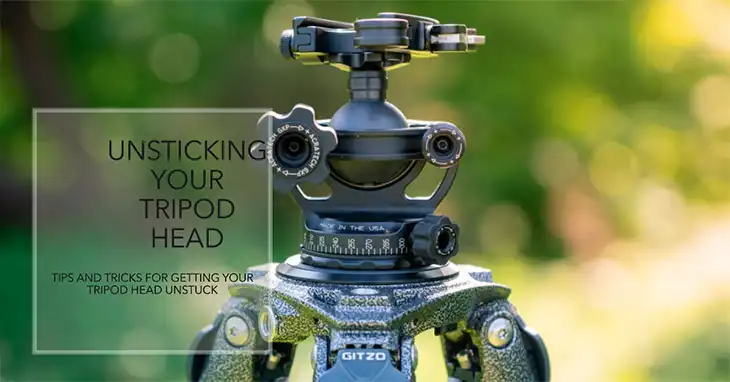Ever gotten to that perfect shooting location, only to find your tripod head frozen solid? It’s a frustrating experience, especially when you risk missing that golden shot.
But how does it get stuck in the first place? And more importantly, how do you get it unstuck? Before we get to that, it’s important that you learn how tripod heads work. Let’s go.

How Tripod Heads Work
Before we get into how to unstuck your tripod head, let’s get acquainted with it first. These nifty contraptions come in various forms:
- Ball Head: Super versatile, offering quick adjustments for both portrait and landscape shots.
- Fluid Head: Beloved by videographers for its smooth, dampened movements.
- Pan-Tilt Head: Provides independent control for panning and tilting, ideal for tracking moving subjects.
- Gimbal Head: Offers ultimate stability for heavy lenses and long exposure photography.
Each type has its strengths and weaknesses, so consider your shooting style when choosing a head.
Why Does My Tripod Head Get Stuck?
Several culprits can lead to a seized tripod head, turning that once smooth-operating marvel into a frustrating obstacle. Here are the usual suspects to keep an eye out for:
Overtightening:
It might seem counterintuitive, but cranking those locking knobs with all your might can actually bind the head, making it difficult (or even impossible) to loosen later.
Dirt and Debris:
Tiny sand particles or dust bunnies, like unwelcome guests, can infiltrate the delicate moving parts of your head, especially in ball heads, causing them to seize up.
Corrosion:
Moisture is the enemy of electronics and machinery alike. If your tripod head has been exposed to moisture for extended periods, rust or corrosion can develop, causing components to stick together.
Misalignment:
A quick-release plate that’s not properly seated can prevent the head from releasing, leaving you scratching your head (pun intended). Double-check that your plate is securely fastened and aligned correctly.
Manufacturing Defects:
While rare, a faulty head straight from the factory could be the culprit. Check your warranty information – you might be entitled to a replacement.
Wear and Tear:
Over time, constant use and heavy loads can cause the internal components of your head to wear down, leading to increased friction and potential binding.
How to Fix a Stuck Tripod Head
Now that you know the enemies, let’s fight them! Here’s a graded approach to freeing your head, starting with the gentlest methods:
Basic Techniques
This might sound counterintuitive, but sometimes, slightly tightening the locking knob can break the friction that’s causing the head to seize. Try giving it a gentle twist in the tightening direction, then see if it loosens more easily.
Remember, brute force is the enemy here! Use controlled pressure in the appropriate unlocking direction to loosen the head. Think of it as a gentle persuasion, not a wrestling match.
A gentle tap with a rubber mallet can sometimes dislodge a stuck head. Focus on tapping the tripod leg, not the head itself to avoid damaging any delicate components.
Intermediate Techniques
A strap wrench provides extra grip without damaging the head’s surface. Choose one with a soft, rubberized strap for maximum control and maneuverability.
Alternatively, you can also use a textured camera grip or jar openers that offer increased leverage when turning the head. Just be sure the grip material is soft enough not to scratch or damage the head’s finish.
Advanced Techniques
A tripod-safe lubricant like a specific camera grease can help loosen tight spots. Apply sparingly to specific areas, then wipe away any excess with a clean cloth. Never use WD-40! It can attract dust and debris, worsening the situation.
As an absolute last resort, a hairdryer on the lowest heat setting might help with stubborn cases. However, this carries the risk of melting plastic parts. Proceed with extreme caution and only if absolutely necessary!
Remember: When in doubt, gentleness is key. If none of these techniques work, consider seeking professional help from a reputable camera repair shop.
How to Prevent Stuck Tripod Heads
An ounce of prevention is worth a pound of cure (and missed shots)! Here are some proactive measures you can take to keep your tripod head happy and functional:
Regular Cleaning: Develop a cleaning routine to remove dirt and debris, the tiny saboteurs that can jam your head’s delicate mechanisms. Use a microfiber cloth to wipe down the exterior, and compressed air can be a lifesaver for blasting dust bunnies out of nooks and crannies.
Proper Storage: When your tripod isn’t in use, store it in a dry, dust-free environment. Silica gel packets can help absorb excess moisture during storage, creating a more hospitable environment for your head.
Avoid Overtightening: Tighten knobs only until snug, not with all your might. Remember, a firm handshake, not a death grip, is all that’s needed.
The Right Plate: Use the quick release plate designed specifically for your head model. A mismatched plate can lead to misalignment and potential binding issues.
Regular Inspection: Take a few minutes every few months to check your head for loose screws, worn parts, or signs of lubrication wear. Addressing these minor issues early on can prevent bigger problems down the line.
FAQ
Can I use WD-40 on my tripod head?
Absolutely not! WD-40 can attract dust and debris, worsening the situation. Use a tripod-specific lubricant or camera grease instead.
My tripod head seems loose and wobbly. What can I do?
Check for loose screws and tighten them with the appropriate screwdriver. If the issue persists, consult a professional for repairs.
I’m a beginner photographer. What type of tripod head should I get?
A ball head is a versatile option for beginners. It offers a good balance of functionality and affordability.
How often should I clean my tripod head?
The cleaning frequency depends on how often you use your tripod and the shooting environment. A light cleaning every few months is a good starting point.
